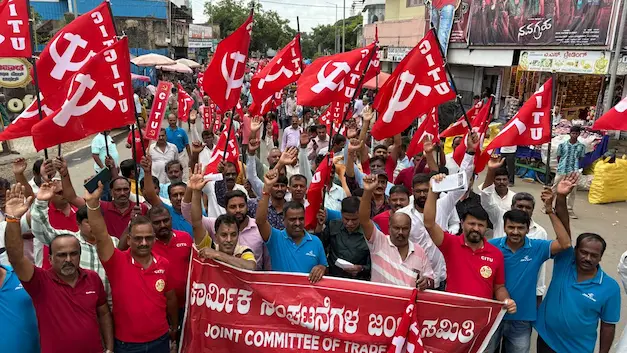
The Bharat Bandh on July 9, 2025, brings economic activity to a standstill across India
Bharat Bandh 2025: What Shut Down, Who Showed Up, and Why It Matters
The dawn of July 9 began with empty roads, shuttered banks, closed post offices, and quiet bus terminals as 25 crore workers and farmers observed the Bharat Bandh, organized by a coalition of trade unions, rural organizations, and left-leaning advocacy groups. The scale was staggering: services in banking, coal mining, public transport, postal networks, and even select educational institutions came to a halt.
The Core Demands:
- Restoration of old pension schemes
- Withdrawal of new labor codes
- Minimum wage hike for informal sector workers
- Protection against corporatization of agriculture
- Halt to privatization of strategic PSUs
Protesters from West Bengal, Punjab, Maharashtra, and Tamil Nadu staged rallies with placards declaring “Save Labor, Save India” while slogans echoed against “anti-worker” and “anti-farmer” reforms. In Delhi, Connaught Place saw brief traffic blocks by worker groups, while major hubs like Kolkata’s Esplanade and Mumbai’s Dadar turned into protest hotbeds.
Trade union leaders, including those from CITU, INTUC, AIKS, and others, hailed the bandh as a “unifying force” that brought disparate communities under one banner of resistance.
The Cost of Silence: Economic, Social and Civic Fallout
While the bandh aimed to amplify voices ignored in policy corridors, it came at a steep price for India’s productivity and civic order.
Economic Losses:
- Estimated ₹8,000 crore hit to GDP due to disruptions in banking, logistics, and fuel supply chains.
- Key sectors like mining and port operations reported a 40-60% decline in output for the day.
- Small businesses and daily wage earners, especially street vendors and transport drivers, faced income losses.
Public Inconvenience:
- School closures left working parents scrambling for alternatives.
- Intercity transport delays caused medical and legal appointments to be missed.
- Critical services like passport offices and municipal helplines operated at minimum capacity.
And yet, despite the disruption, many urban citizens expressed support for the underlying causes. Social media witnessed hashtags like #BharatBandh2025 and #JusticeForWorkers trending, with public debates unfolding on platforms like X and LinkedIn.
Critics of the bandh, largely corporate associations and chambers of commerce argued that economic reform cannot be held hostage by strike tactics. But defenders countered that civil disobedience is essential when institutional channels fail.
The Legacy of Bharat Bandh: Outdated Protest or Democratic Power Tool?
Bharat Bandh isn’t new. Since the 1970s, this mass strike model has served as a tool for resisting economic reforms, asserting labour rights, and building solidarity across India’s fragmented workforce. But in 2025, the question lingers: Does it still work?
Why It Still Resonates:
- Offers visibility to marginalized groups often left out of policy tables.
- Forces media coverage of underreported issues like worker safety and pension dismantling.
- Builds political leverage in an era of corporate lobbying and centralization.
Where It Falls Short:
Despite its emotional and historical resonance, the Bharat Bandh as a protest tool struggles to deliver sustained impact in a rapidly evolving India.
Limited Policy Change
One-day strikes, no matter how large, rarely compel immediate legislative reversals unless paired with long-term engagement, lobbying, and negotiation. Without follow-up dialogue or a sustained campaign strategy, the message often fades once normalcy resumes.
Disconnect with Urban Middle Class
Bandhs disproportionately affect urban professionals and small business owners who rely on daily operations. The absence of nuanced messaging can alienate this demographic, weakening public sympathy and diluting broader support for the cause.
Economic Repercussions
While designed to pressure power structures, nationwide shutdowns often hit daily wage workers, vendors, transport operators, and small entrepreneurs hardest, ironically hurting the very communities the bandh aims to uplift. Lost income, supply chain delays, and increased volatility erode grassroots resilience.
Strategic Fatigue
In an era of fast digital activism and institutional advocacy, traditional bandh tactics run the risk of becoming symbolic rather than effective. Repeated disruptions without tangible outcomes can trigger protest fatigue, making it harder to mobilize citizens when stakes are higher.
Diluted Media Narrative
With sensational headlines dominating news cycles, bandhs may struggle for coverage unless they present fresh perspectives or strategic framing. Without a compelling story arc, beyond disruption, the movement risks being perceived as noise, not necessity.
Stay updated with the latest news on Rapido Updates. Keep yourself updated with The World, India News, Entertainment, Market, Automobile, Gadgets, Sports, and many more